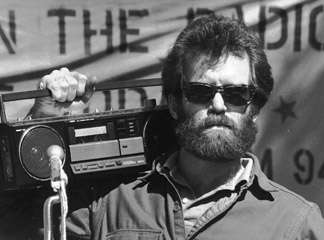 [John Rieger’s three-year bi-weekly late-night experiment in radio programming, Artifacts: KPFA-Berkeley 1985-1987, introduced the idea of “audiography”…]
[John Rieger’s three-year bi-weekly late-night experiment in radio programming, Artifacts: KPFA-Berkeley 1985-1987, introduced the idea of “audiography”…]
“Artifacts” is an experiment in the esthetics of non-narrative audio figuration and thematic organization. The sound recording media have produced figurative works primarily in such narrative forms as journalism and drama. Non-narrative audio composition has been understood as a musical enterprise rather than a figurative one. The poverty of this accepted wisdom is suggested by the analogy with photography. While painting begins with “stuff” — paint, the elementary color stuff — photographic composition begins with what might loosely be called “semantic” elements, visual records of world objects which contain a world reference. Photography has a passive or receptive moment which painting does not; for while painting may be a wholly abstract enterprise, photography must at least begin from the figuration which occurs when the film receives the light image from the world object.
So we may compare sound recording with musical composition. Music begins with the elementary sound stuff, whose fundamental property, we shall say, is timbre. Sound recording, however, begins with the passive or receptive moment which we noted in photography, where in this case the audio image of the world object is received and recorded. Sound recording is “audiographic”. But while photographic figuration has long since freed itself from the compositional constraints of the narrative tableau and the news photo, audiographic figuration still serves almost exclusively the dramatist and the journalist. Only by considering the audiographic record as sound stuff (musique concrete) have we managed to break these narrative shackles; but in so doing we have lost the reference to the world object and so destroyed the audiographic image qua image.
Surely, then, we have not yet exhausted this remarkable medium!
Audiography records only the mystery. Radio journalism has fought against this mystery, doing appalling violence to what is subtle, ambiguous and profound in the name of clarity, and strapping the unruly “actuality” into a straightjacket of anemic literalism.Consider the richness of the audiographic image. Unencumbered by the superabundance of banal visual information against which photographers and filmmakers have had to struggle to uncover what is mysterious in the Thing, audiography records only the mystery. Radio journalism has fought against this mystery, doing appalling violence to what is subtle, ambiguous and profound in the name of clarity, and strapping the unruly “actuality” into a straightjacket of anemic literalism. (Or perhaps it is the journalist who wears the straightjacket.) Radio drama, with equal violence, reduces the audiographic image to a sound “effect”, playing a perpetually supporting role, and coming and going by the servants’ entrance. Should the image then seek the seductive embrace of musique concrete it will find only the ultimate subjugation, its destruction.
“Artifacts”, then, is the audiographic annunciation of the Thing. It heralds the esthetic of the blank stare. It calls upon us not to subjugate the image, but to receive it as it is for-itself; for within these audiographic artifacts objects lead lives of their own, revealing in their gravitational attraction one to another the unconscious mass, the hidden psychic substance which sustains them. They are to be approached not with a will to mastery, but with an attitude of reverence and humility befitting one on whom a thing of mysterious beauty has been bestowed.
–John H. Rieger, June 17, 1985
Riegs on: New American Radio | DNA Files | Hearing Voices |
Science and the Search for Meaning
The above Audiographic essay was performed live on-air by the author, with Catherine Stifter and Steve Tokar, on their KPFA program, “Artifacts: Manifesto, 1985” (7:58 mp3):
Leave a comment: